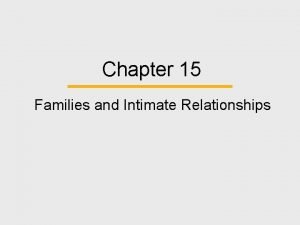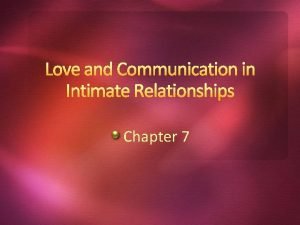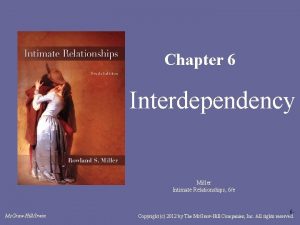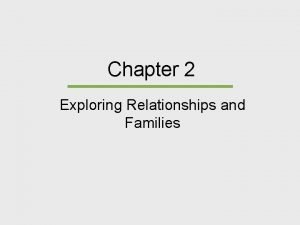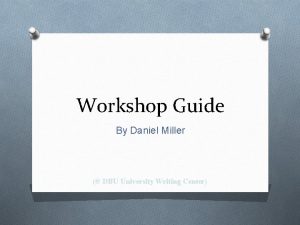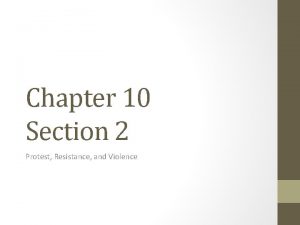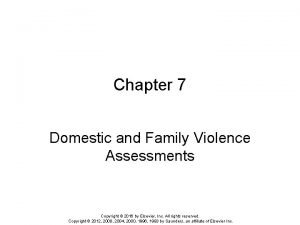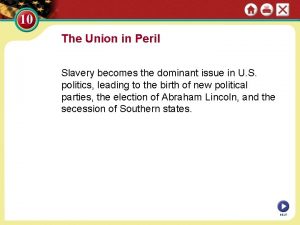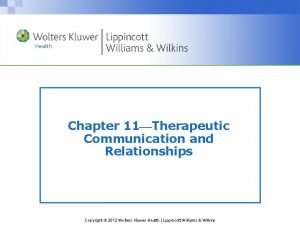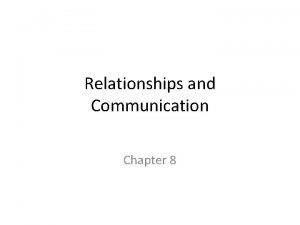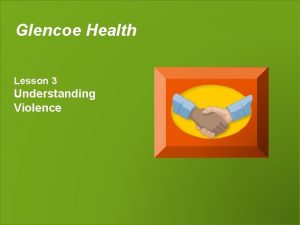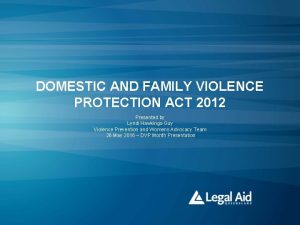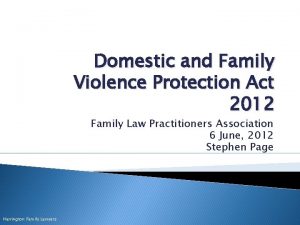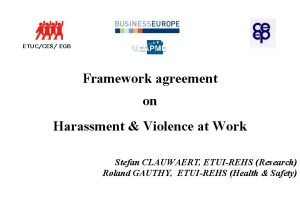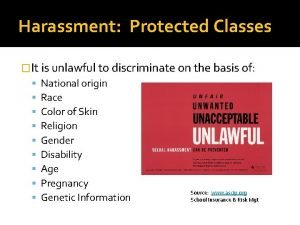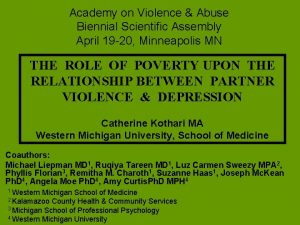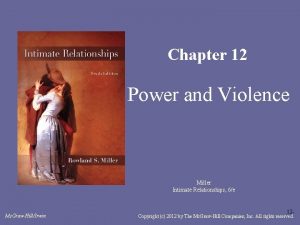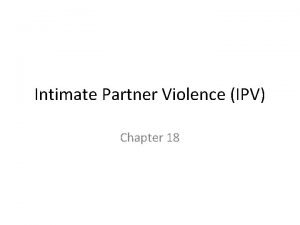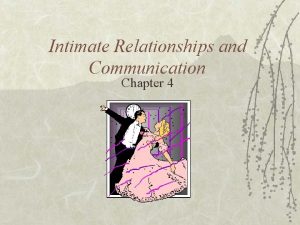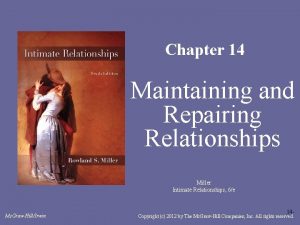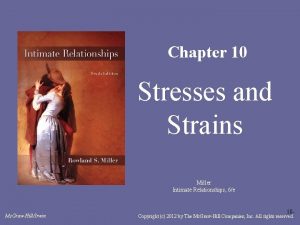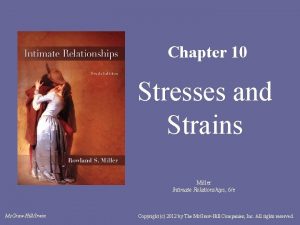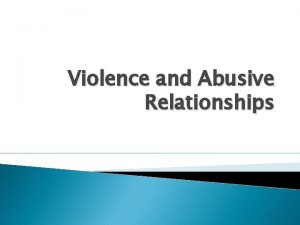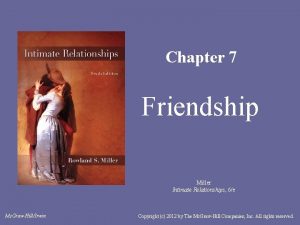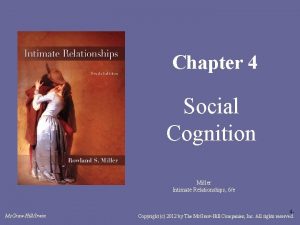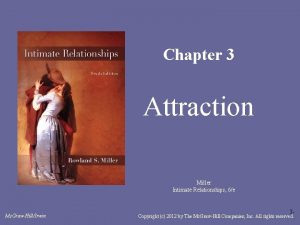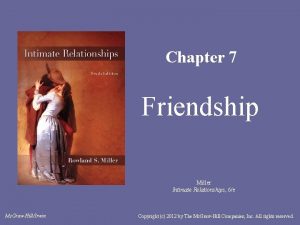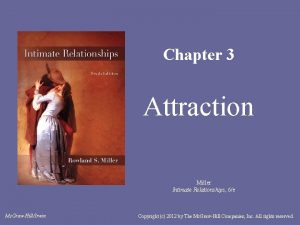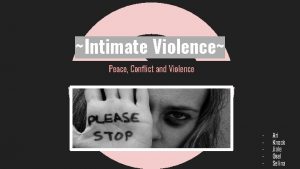Chapter 12 Power and Violence Miller Intimate Relationships




































- Slides: 36

Chapter 12 Power and Violence Miller Intimate Relationships, 6/e Mc. Graw-Hill/Irwin Copyright (c) 2012 by The Mc. Graw-Hill Companies, Inc. All rights reserved.

Power and Interdependency What is Power? • Influence others • Resist others 12 -2

Power and Interdependency Sources of Power in Relationships: From an interdependency creates power – Control Access to Resources (children, money) – Demand for Resources = creates Power – Power is reduced if Resources readily available 12 -3

Power and Interdependency Sources of Power principle of lesser interest Difference in Dependency creates Power If your partner loves and needs you more than you love him or her, you’ll get to do what you want more often than not. 12 -4

Power and Interdependency Sources of Power There are two different broad types of power: – Fate control allows one to control a partner’s outcomes no matter what the partner does. (e. g, Divorce Threats) – Behavior control allows one to encourage, but not compel, desired behavior from a partner. (e. g. , Affection contingent on specific behaviors) 12 -5

Power and Interdependency Sources of Power Healthy Relationships: Mutual Power Thus, one partner’s ability to influence the other is often matched by considerable counterpower of the other partner over the first. 12 -6

Power and Interdependency Types of Resources • Six different resources provide people power over others: – Reward power – Coercive power – Legitimate power – Referent power – Expert power – Informational power 12 -7

Power and Interdependency Types of Resources • Reward power is the ability to bestow desired rewards; these may be either tangible, material goods or intangible, interpersonal benefits. 12 -8

Power and Interdependency Types of Resources • Coercive power is the ability to levy unwanted punishments, doing something a partner doesn’t like, or taking away something the partner does like. 12 -9

Power and Interdependency Types of Resources • Legitimate power exists when one partner has a reasonable right – by dint of authority, equity, or reciprocity – to tell the other what to do. 12 -10

Power and Interdependency Types of Resources • Referent power emerges from respect and love for a partner. Affection and adoration from another provides one some ability to influence that other person. 12 -11

Power and Interdependency Types of Resources • Expert power exists when one partner has superior knowledge and experience that is recognized and acknowledged by the other. • Finally, informational power exists when one partner has specific pieces of information that the other wants. 12 -12

Power and Interdependency Men, Women, and the Control of Resources • Men and women: Differences in relative resources. • Some resources that provide people power can be used more flexibly than others can. – Universalistic resources (such as money) can be exchanged with almost anyone in a wide variety of situations. – Particularistic resources are valuable in some situations and not in others, and they confer power to their owner only with particular partners. 12 -13

Power and Interdependency Men, Women, and the Control of Resources Love is a particularistic resource: we give Referent power over one who loves us • • • Men control more universalistic resources (money) that are widely influential in social life Women control more particularistic resources (nurturance) NO surprise us to find men being more influential than women in many relationships. 12 -14

Power and Interdependency The Process of Power • Nonverbal Sensitivity: - Women decode others’ nonverbal communications more accurately than men. - Powerful people tend to be relatively insensitive to others’ feelings. 12 -15

Power and Interdependency The Process of Power • Styles of Power: Influence tactics may be overt and direct, or indirect and implicit. bilateral : involving both members of a couple in negotiation and bargaining unilateral, with individuals doing what they want without involving their partners. 12 -16

Power and Interdependency The Process of Power • Styles of Power (continued): - There are no sex differences in the tactics people use in same-sex partnerships, - but men tend to be more direct and bilateral, and - women more indirect and unilateral, in heterosexual relationships. They hint about what they want. 12 -17

Power and Interdependency The Process of Power • Styles of Power (continued): Why the Gender Differences? – First, masculinity associated with more direct and bilateral than feminine people are. – Second, traditional norms accord husbands more status than wives, and high-status people are more direct and bilateral than people of lower status are. 12 -18

Power and Interdependency The Process of Power • Styles of Power (continued): Norms are changing which is a good thing…. – People who have to hint and pout to get (some of) what they want tend to be less content than are those who can come right out and ask for what they desire. 12 -19

Power and Interdependency The Outcome of Power • In a culture of male dominance create gender inequalities in our daily interactions. • These subtle imbalances of power can be hard to detect. • Equal Partnerships create happiness, with women benefiting more than men. However, both are made happier. 12 -20

The Two Faces of Power There’s a dark side to power. Abuse of Power, particularly referent power. 12 -21

The Two Faces of Power Healthy Benevolent Power: Power need not be a corrosive, deleterious thing. Committed, happy lovers often use their influence to benefit their partners and to enhance, rather than undermine, their mutual contentment. 12 -22

Violence and Abuse in Relationships Violence involves acts carried out with the intention of physically hurting another person. Violent actions range from those that do little harm, such as grabbing or pushing, to others that inflict atrocious injury. 12 -23

Partner Violence Documentary • “Living in Fear” – Group Discussion – Take notes on documentary focusing on facts/statistics 12 -24

Myths about Intimate Violence • 1. “Couples Violence is Rare” – 22% Women, 7% Men – Women 5 x intimate violence, 33% murdered by partner • 2. Women are not violent • 3. Only Unhappy Couples hit: Newlyweds Study • 4. Violence happens only in marriage otherwise they would leave. 12 -25

Truths about Intimate Violence • 1. Intimate Partner Violence is Prevalent • 2. Violence is Mutual • 3. Intimate Partner Violence unrelated to satisfaction • Note Exception: Intimate Terrorism: Clinical and Forensic Sources of Data 12 -26

Violence and Abuse in Relationships Types of Couple Violence – Situational couple violence erupts from specific angry arguments that get out of hand. (Developed from surveys) – Intimate terrorism, one partner uses violence as a tool to control and oppress the other. (Developed from clinical cases) • Mutual violent control, which is uncommon, occurs when both partners engage in intimate terrorism. • Violent resistance occurs when a partner forcibly fights back. 12 -27

Violence and Abuse in Relationships Correlates of Common Couple’s. Violence Most acts of intimate violence are situational couple violence (SCV) or Intimate Partner Violence Situational Couple Violence: (common – 22%) • Instigating triggers: Argument, Alcohol • Male=Female • Can be Fatal • Poor Coping of Conflict • No Abuse Cycle • Can exist in happy couples 12 -28

Intimate Terrorism • • • No Triggers Male Perpetrators Fatal Not related to stress, drugs, alcohol Couples low Satisfaction: most dissolve in 2 yr Perpetrators : Sociopathic, Borderline, Narcissistic Personality Traits • Abuse is about attaining Power 12 -29

Violence and Abuse in Relationships Why Don’t They All Leave? Cycle of Violence: Tension Building(withdrawal, appeasement, “walking on egg shells”) -> Violence (explosive, increasing) >Remorse/Idealization (gifts, sex, affection, doting) Creates: “Learned Helplessness: Helplessness/Fear 1. Loss of sense of Self-Mastery 2. Self-Blame, Destroy self-identity 3. Clinical Depression/PTSD 12 -30

Treatment for Intimate Terrorism • • • Legal/ Criminal Consequences Protection for Victim and children Leaving Relationship Financial/Employment support for victim Therapy to help support improvements in selfmastery and resolution of trauma. 12 -31

Victims of Intimate Terrorism • • • Traditional Gender Roles Accept Responsibility of Abuse Low Self-Esteem Guilt for abuse and ideas of leaving Uses sex to establish intimacy and placate abuser • Believes no one will help her except self • Hyper attuned to moods/needs of batterer 12 -32

Perpetrator of Intimate Terrorism • Gradual process of Isolation, Emotional Control, Financial Control, Violence • Low Self-Esteem • Traditional Male Superiority View • Pathologically jealous • Can be Charming and Manipulative • Holds others responsible for his feelings/actions 12 -33

Perpetrator’s Primitive Defenses • Borderline PD: – Diffuse Identity – Changeable sense of self -Splitting: see spouse as all bad, or all good tension building phase: the ego inflation lessens, feels devalued again - Projective Identification: Project shame on partner - Primitive Denial: No response to their emotional contradictions - Reality Testing: Difficulty distinguishing own thoughts from others. 12 -34

Violence and Abuse in Relationships General Correlates of Violence is less likely: • • cultures promoting gender equality conscientious people Couples with good Conflict Management skills Married Couples<Cohabitating Couples<Dating Couples 12 -35

Examination of Cases of Abuse • Group Work: Handout with Case Studies: – Distinguish Situational Couple Violence vs Intimate Terrorism 12 -36
 Periwinkle doerfler
Periwinkle doerfler Intimate relationships, marriages, and families 9th edition
Intimate relationships, marriages, and families 9th edition Love and communication in intimate relationships
Love and communication in intimate relationships Friendly relationship chapter 7
Friendly relationship chapter 7 The impact of incarceration on intimate relationships
The impact of incarceration on intimate relationships Intimate family chapter 6
Intimate family chapter 6 Intimate family chapter 6
Intimate family chapter 6 Intimate family chapter 2
Intimate family chapter 2 Intimate family chapter 2
Intimate family chapter 2 Miller
Miller Daniel miller arthur miller
Daniel miller arthur miller Medical plaza miller 131 miller street
Medical plaza miller 131 miller street Chapter 9 lesson 2 resolving conflicts
Chapter 9 lesson 2 resolving conflicts Chapter 27 anger aggression and violence
Chapter 27 anger aggression and violence Chapter 10 section 2 protest resistance and violence
Chapter 10 section 2 protest resistance and violence Chapter 9 resolving conflicts and preventing violence
Chapter 9 resolving conflicts and preventing violence Chapter 10 section 2 protest resistance and violence
Chapter 10 section 2 protest resistance and violence Chapter 7 domestic and family violence assessment
Chapter 7 domestic and family violence assessment Chapter 10 section 2 protest resistance and violence
Chapter 10 section 2 protest resistance and violence Power triangle diagram
Power triangle diagram Intimate distance is:
Intimate distance is: Consultative register conversation examples
Consultative register conversation examples Dewgarden foaming intimate wash benefits
Dewgarden foaming intimate wash benefits Zones of space communication
Zones of space communication Intimate zone in communication
Intimate zone in communication Cankaya university
Cankaya university Me line 02 intimate
Me line 02 intimate Abcde of intimate relationship
Abcde of intimate relationship Chapter 9 lesson 3 understanding violence
Chapter 9 lesson 3 understanding violence Modifiers of human acts passion examples
Modifiers of human acts passion examples Domestic and family violence protection act 2012
Domestic and family violence protection act 2012 Gandhi king and mandela what made non-violence work dbq
Gandhi king and mandela what made non-violence work dbq S68r family law act
S68r family law act Framework agreement on harassment and violence at work
Framework agreement on harassment and violence at work Workplace violence and harassment quiz answers
Workplace violence and harassment quiz answers Academy on violence and abuse
Academy on violence and abuse Indicators of potential workplace violence
Indicators of potential workplace violence

